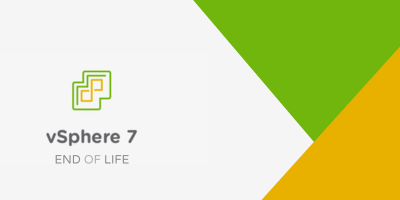
What Does Vsphere 7 End of Life Mean for the Vmware Ecosystem?
- Bare Metal | Cloud | Insights
The last few years have brought seismic changes in the virtualization industry. When Broadcom completed its acquisition of VMware on November 22, 2023, the industry didn’t immediately understand the scale of what was coming. But today it’s clear: support lifecycles, license models, cloud bundles, and upgrade paths are being rewritten.
Broadcom is framing this shift as product simplification, paring VMware down to two core offerings: The VMware Cloud Foundation (VCF) private cloud stack and the smaller VMware vSphere Foundation virtualization platform, plus a set of add-on services.
Let’s walk through a timeline of key milestones, explore what the end of vSphere 7 support means, and examine how businesses of all sizes are being affected.
Key Milestones in VMware’s Broadcom Transition
- November 22, 2023: Broadcom completes its $69 billion acquisition of VMware.

- 2024: Broadcom begins phasing out perpetual VMware licences and shifts customers toward subscription-only bundles (notably via the VCF platform).
- July 15, 2025: Broadcom announced a major consolidation of the VMware Cloud Service Provider (VCSP) Program.
- October 2, 2025: End of general support for vSphere 7, vSAN 7, and vCenter 7.
- October 15, 2025: Last day to buy VMware-licensed nodes on Google Cloud VMware Engine and other public cloud platforms.
- November 1, 2025: Broadcom enforces a “bring your own licence” model for VCF on public cloud providers.
What is VMware vSphere 7?
Released in 2020, vSphere 7 became a cornerstone for many organizations adapting to the pandemic. As remote work and digital demand surged, it provided the reliability and scalability businesses needed.
The newly upgraded platform unified virtual machines and Kubernetes containers. It improved automation, security, and lifecycle management through features like a redesigned lifecycle manager, a streamlined vCenter Server Appliance, and enhanced identity federation.
Since it supported both traditional and cloud-native applications, vSphere 7 defined virtualization during a pivotal moment.
How did the end of vSphere 7 affect organizations?
Under Broadcom, the rules changed fast. As Iain Saunderson, CTO at IT service provider Spinnaker Support, said in September, “If you don’t upgrade or renew, whatever the case might be, you will not get support from Broadcom, full stop.”
Since October 2, 2025, security patches, bug fixes, and vendor support for vSphere 7 have stopped. Organizations that ran vSphere 7 faced a clear choice: upgrade to Vmware vSphere 8, migrate, or stay on an unsupported platform.
For many, the change marked a major cultural and financial shift. Those used to perpetual licenses, multiple support tiers, or incremental upgrades over many years were pushed toward a subscription bundle or a migration path.
The transition also introduced operational uncertainty, as service providers and end customers alike were forced to re-evaluate budgets, renewal timelines, and long-term platform strategies.
How are public cloud providers being impacted?
The changes don’t stop at VMware vSphere 7. Public cloud vendors that offered VMware-based infrastructure are caught in the shift, too.
Google Cloud VMware Engine Product Team discusses the change on their blog, “Broadcom recently announced a change to its VMware licensing model for hyperscalers, moving to an exclusive ‘bring your own’ subscription model for VMware Cloud Foundation (VCF) starting on November 1, 2025.”
Jim Gaynor, Editorial Vice President at Directions on Microsoft, also recently stated, “This latest change moves VCF to what Broadcom calls a license portability-only operating model. This means hyperscalers like Microsoft and Amazon can’t bundle VCF licenses in their offerings, and customers have to purchase licenses directly from Broadcom (or its reseller partners) to bring with them in a bring your own license (BYOL) scenario.”
Under Broadcom’s new model, public cloud providers can no longer bundle VCF licenses with their services.
Customers must purchase VCF subscriptions separately—either from Broadcom itself or from one of Broadcom’s authorized reseller partners—and then apply those licenses to their chosen environment.
What used to be a single, turnkey purchase through a cloud provider now requires multiple transactions, additional contract management, and tighter version control.
It also limits flexibility, since expanding workloads in Google Cloud, Azure, or AWS now depends on having available Broadcom-issued licenses. As a result, many will potentially face delaying deployment times and increased TCO.
What’s the impact of VMware vSphere 7 end of life for businesses?
For many enterprises and small businesses, the shift isn’t theoretical. It’s hitting budgets, operations, and strategy.
An IT director for a school district in Indiana illustrated the strain. The district, which serves about 3,000 students, used VMware’s vSphere virtualization platform and vSAN storage as part of a Dell VxRail hyperconverged infrastructure package. The setup allowed students to gain real-world IT experience by working directly with virtual machines.
Broadcom’s acquisition of VMware triggered a dramatic licensing price increase for the school district. They received a quote that was three to six times higher than expected, a change that put its existing environment out of reach.
“It’s the same software — nothing major changed — yet the cost exploded,” the IT director said. “We aren’t getting more features, just paying way more.”
The district can now no longer maintain the same VMware setup. The IT team has had to redirect time and budget away from classroom projects and into migration planning or finding a more affordable alternative.
Students have lost access to the enterprise-grade tools that once formed the backbone of their IT curriculum.
The problem also extended beyond licensing fees. According to the IT director, Dell will not provide long-term support for the VxRail hardware if it’s no longer running VMware. This has left the district stuck between paying higher software costs or losing vendor-backed maintenance for its infrastructure.
This situation highlights the growing risks of vendor lock-in. When a single company controls both licensing and hardware integration, even small changes in pricing or support can have far-reaching consequences for a company’s operations.
Looking to migrate without overlap costs?
Migration shouldn’t drain your budget. With HorizonIQ’s 2 Months Free, you can move workloads, skip the overlap bills, and gain extra time to switch providers without double paying.
Get 2 Months FreeWhat does this mean for VMware’s future?
VMware currently has roughly 375,000 paying customers worldwide. In its most recent earnings report, Broadcom’s software revenue, primarily driven by VMware sales, soared 25% YoY to $6.6 billion during the quarter.
However, that topline number hides a sharp strategic pivot. Organizations are taking note of the changes and VMware’s future, and many are planning their next steps.
According to Gartner Research VP, Julia Palmer, 35 percent of VMware workloads are expected to migrate elsewhere by 2028. That figure represents a significant erosion of VMware’s installed base and a clear signal that customers are seeking alternatives.
At the same time, Broadcom is doubling down on its preferred path. At VMware Explore 2025, they used the stage to declare that the “future is private cloud.”
CEO Hock Tan proclaimed, “With VCF 9.0, private cloud now outperforms public cloud. It has better security, better cost management, and of course, greater control.”
Broadcom is marketing VCF as the future platform. The company is no longer positioning itself as a broad virtualization platform for every organization, but as a premium private-cloud provider serving large enterprises willing to invest heavily in VCF.
As Tan notes, “If you’re going to do cloud, do it right. Embrace VCF 9 and stay on-premise.”
Within the coming years, smaller customers and public cloud providers will be deprioritized, perpetual licenses will fade, and long-time users will be pushed toward expensive, subscription-based bundles.
Time will only tell what this means for VMware’s future.
What should IT decision-makers be doing now?
Here are four key steps to consider:
- Audit your VMware footprint
Identify how many hosts, clusters, and workloads you’re running on vSphere 7 (or earlier) and whether they fall under perpetual support or have renewal windows. - Map your licence and support expiry dates.
If you’re on vSphere 7 and rely on vendor support, the October 2, 2025, date was non-negotiable. Failure to upgrade meant going unsupported. - Build a cost model that factors in licensing, migration, and support
Don’t look at just the next year’s renewal fee. Include upgrade time, staff retraining, migration risks, hardware compatibility, and alternative platform costs. - Explore alternatives early
The earlier you assess, the more options you have. If you wait until you’re forced by deadlines, your negotiation power shrinks, and costs grow. Whether that means migrating to vSphere 8/VCF, shifting workloads to public cloud, or adopting a new virtualization/hyper-converged stack.
How can HorizonIQ help you during the VMware vSphere 7 end of life transition?
At HorizonIQ, we help customers take the right path for their business. Whether that means upgrading to VMware vSphere 8, migrating to our Proxmox Managed Private Cloud, or running workloads on other platforms, we’re here to help you make the right choice.
Why teams choose HorizonIQ:
- Flexibility: Support for VMware vSphere 8, Proxmox, other virtualization platforms, and hybrid deployments.
- Lower costs: Flat-rate pricing with 2 months free for migration, so you’re not paying two providers.
- Proven performance: We’ve successfully migrated our own infrastructure from VMware to Proxmox.
No matter which platform you choose, HorizonIQ is here to make sure your infrastructure stays optimized, supported, and ready for what’s next.


